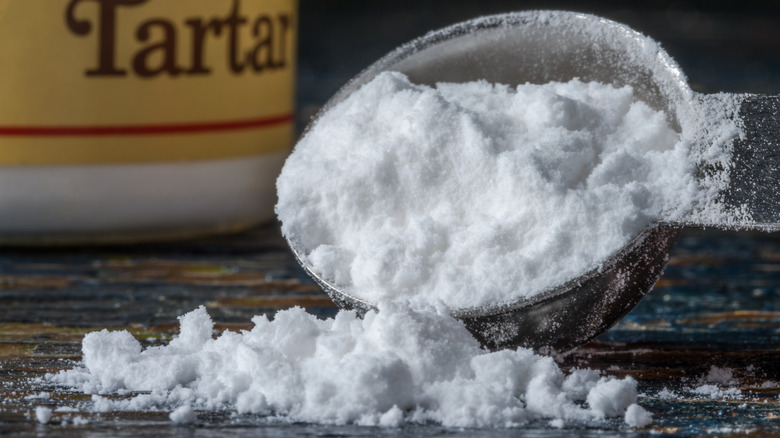Why You Should Be Seasoning Your Tomatoes With Cream Of Tartar
Arguably, there are three types of people. The first two are those who have never heard of cream of tartar and those who know they have cream of tartar in their house but have no idea what it really is. And then there are the people who have at some point in their life, crammed like crazy to use the ingredient for pastry school or for "Great British Bake Off" tryouts.
So what is cream of tartar? Per Healthline, cream of tartar is also known as potassium bitartrate — which may remind you of store-cupboard staple baking soda (sodium bicarbonate), and rightly so. Both cream of tartar and baking soda are stable, cheap, white powders that you can use around the house to adjust the pH of some foods.
According to McGill University, cream of tartar is a mild acid formed as a byproduct of winemaking. Some baking powder formulations use both baking soda and cream of tartar, an alkali, and acid, to generate carbon dioxide bubbles to help cakes rise, for example.
Adjusting pH isn't just about bubbles though. Raising the pH of a dish with baking soda can make onions brown faster, shrimp snappier, and help take your hummus from earthy mush to ethereal mousse. It's just about knowing when to use it. Cream of tartar lowers the pH of anything it is added to, and as Slate explains, this makes cakes crumble more tenderly, meringues shine ivory-white, and egg whites whip up with ease.
Why use cream of tartar to season tomatoes?
When you want to understand why something tastes good, looking at what substitutions are suggested can be handy. The Spice House points out that the best substitution for cream of tartar depends on the situation, but the most frequently used is two teaspoons of lemon juice or vinegar in place of one teaspoon cream of tartar, in order to replicate the acidity needed. However, as America's Restaurant notes, these substitutions have the drawback of changing the taste of the dish — lemon juice being better for sweet subs, and vinegar for savory.
This is why, according to Cook's Illustrated, your tomatoes deserve seasoning with cream of tartar, next time. Amping up the acid in any way is going to make the sour notes of the tomato pop and zing, but by using cream of tartar instead of say, balsamic vinegar, you'll get to enjoy a truly tomatoey tang with nothing masking its natural flavors, only enhancing them, as good seasoning should.
That's not to say that cream of tartar is the only thing to put on your tomatoes! Salt, as always is essential. If you're helping the salty and sour sides out, then a small pinch of sugar may be called for, for the sake of balance. Black pepper is a classic source of warmth, but as Fine Dining Lovers reminds us, there are more peppers out there, so don't be afraid to experiment until you find your favorite!

